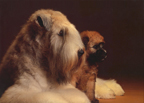Teaching children to interact safely with puppies
By Joan Weston
Timmy and ‘Lassie.’ Elroy and ‘Astro.’ Stewie and ‘Brian.’ The kids and dogs folklore is everywhere. It’s enough to make you wonder why the nursery at Saint Petunia’s doesn’t just hand out a free puppy with every baby delivered as part of its incentive program.
Perhaps surprisingly, kids and dogs aren’t always a great match. Parents who have youngsters and then opt to add a puppy understand this all too well after the fact. “I love my kids and ‘Trinity,’ but it’s really hard to do this,” laments one mom, “if I’d realized how much work it was going to be, I’d have definitely waited.”
Keeping puppies safe
While we often worry about our children’s safety around dogs, the puppy may be in more danger than your six year old. Children are impulsive and can be easily frustrated when a dog doesn’t understand or do what they want. They may lash out at the dog in a moment
of anger.
There are some ways that you can safely blend a family with kids and dogs. First, start with realistic expectations. A puppy isn’t going to transform your kid into a responsible adult. While you can expect that you may be able to cajole your child into the occasional feeding, don’t scold him when he doesn’t. He’s the kid; you’re the parent. I wanted a drum set, chickens and a go-cart at different times in my childhood. My parents had the good sense to deny me those things. Berating your child for not taking care of the dog will only cause him to resent the new pup, and damage the relationship that you’re hoping they’ll form.
Breed considerations
Consider getting a medium-sized breed such as an American Cocker Spaniel. While smaller breeds can be fun, they also require more supervision, because children tend to treat them like toys. Kids are more likely to be inappropriate by hugging and carrying a dog that looks like a toy to them.
Another option is to adopt an adult dog that has a proven track record with children. Getting an adult means the children are more likely to treat him like a dog from the start, and he’ll be more used to dealing with kids and their capriciousness.
Provide safe spots
Get a few crates or an exercise pen and leave them around the house. Placed in multiple rooms, they’re a great way for the puppy to be with the family and still be safe when parents are busy. A toddler can easily learn that when the puppy is in its ‘bedroom’ the child cannot go in or stare at them.
We all love our pets, but it’s important to teach children how to show affection safely. The two big No’s are picking up puppies and hugging. Both can result in injuries to the dog. Petting is done with one hand on a dog at a time, not two. This helps to insure that the dog can get away if he feels uncomfortable.
Walking the dog
The minimum age for a child to safely walk a dog alone is 14. Sending an eight year old out to walk a dog is irresponsible; you’re setting both up for disaster. What if your dog pulls away to chase a squirrel across a road, or another dog attacks your dog? Both instances can result in injury or death and a child should not be put in that position.
Kids and dogs can be best friends, but it takes planning and time to ensure that both partners remain safe with each other. Starting on the right foot lays the foundation for a loving animal-human bond that will last a lifetime.

